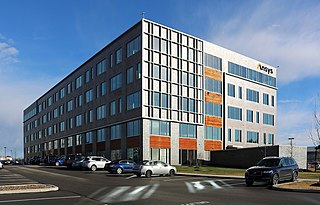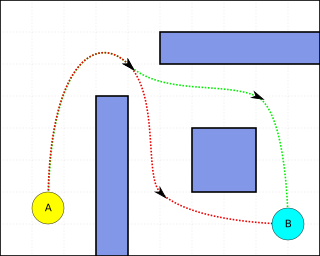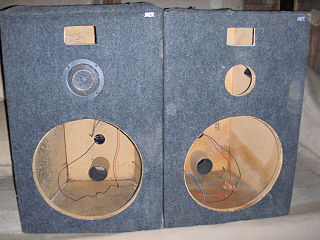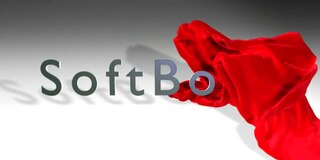Related Research Articles

An electrical network is an interconnection of electrical components or a model of such an interconnection, consisting of electrical elements. An electrical circuit is a network consisting of a closed loop, giving a return path for the current. Thus all circuits are networks, but not all networks are circuits. Linear electrical networks, a special type consisting only of sources, linear lumped elements, and linear distributed elements, have the property that signals are linearly superimposable. They are thus more easily analyzed, using powerful frequency domain methods such as Laplace transforms, to determine DC response, AC response, and transient response.

LS-DYNA is an advanced general-purpose multiphysics simulation software package developed by the former Livermore Software Technology Corporation (LSTC), which was acquired by Ansys in 2019. While the package continues to contain more and more possibilities for the calculation of many complex, real world problems, its origins and core-competency lie in highly nonlinear transient dynamic finite element analysis (FEA) using explicit time integration. LS-DYNA is used by the automobile, aerospace, construction and civil engineering, military, manufacturing, and bioengineering industries.
In electrical engineering and electronics, a network is a collection of interconnected components. Network analysis is the process of finding the voltages across, and the currents through, all network components. There are many techniques for calculating these values; however, for the most part, the techniques assume linear components. Except where stated, the methods described in this article are applicable only to linear network analysis.

Ansys, Inc. is an American multinational company with its headquarters based in Canonsburg, Pennsylvania. It develops and markets CAE/multiphysics engineering simulation software for product design, testing and operation and offers its products and services to customers worldwide.

Pathfinding or pathing is the plotting, by a computer application, of the shortest route between two points. It is a more practical variant on solving mazes. This field of research is based heavily on Dijkstra's algorithm for finding the shortest path on a weighted graph.

Mesh generation is the practice of creating a mesh, a subdivision of a continuous geometric space into discrete geometric and topological cells. Often these cells form a simplicial complex. Usually the cells partition the geometric input domain. Mesh cells are used as discrete local approximations of the larger domain. Meshes are created by computer algorithms, often with human guidance through a GUI, depending on the complexity of the domain and the type of mesh desired. A typical goal is to create a mesh that accurately captures the input domain geometry, with high-quality (well-shaped) cells, and without so many cells as to make subsequent calculations intractable. The mesh should also be fine in areas that are important for the subsequent calculations.
The finite element method (FEM) is a powerful technique originally developed for numerical solution of complex problems in structural mechanics, and it remains the method of choice for complex systems. In the FEM, the structural system is modeled by a set of appropriate finite elements interconnected at discrete points called nodes. Elements may have physical properties such as thickness, coefficient of thermal expansion, density, Young's modulus, shear modulus and Poisson's ratio.

A loudspeaker enclosure or loudspeaker cabinet is an enclosure in which speaker drivers and associated electronic hardware, such as crossover circuits and, in some cases, power amplifiers, are mounted. Enclosures may range in design from simple, homemade DIY rectangular particleboard boxes to very complex, expensive computer-designed hi-fi cabinets that incorporate composite materials, internal baffles, horns, bass reflex ports and acoustic insulation. Loudspeaker enclosures range in size from small "bookshelf" speaker cabinets with 4-inch (10 cm) woofers and small tweeters designed for listening to music with a hi-fi system in a private home to huge, heavy subwoofer enclosures with multiple 18-inch (46 cm) or even 21-inch (53 cm) speakers in huge enclosures which are designed for use in stadium concert sound reinforcement systems for rock music concerts.

Soft-body dynamics is a field of computer graphics that focuses on visually realistic physical simulations of the motion and properties of deformable objects. The applications are mostly in video games and films. Unlike in simulation of rigid bodies, the shape of soft bodies can change, meaning that the relative distance of two points on the object is not fixed. While the relative distances of points are not fixed, the body is expected to retain its shape to some degree. The scope of soft body dynamics is quite broad, including simulation of soft organic materials such as muscle, fat, hair and vegetation, as well as other deformable materials such as clothing and fabric. Generally, these methods only provide visually plausible emulations rather than accurate scientific/engineering simulations, though there is some crossover with scientific methods, particularly in the case of finite element simulations. Several physics engines currently provide software for soft-body simulation.
In statistics, a Yates analysis is an approach to analyzing data obtained from a designed experiment, where a factorial design has been used. Full- and fractional-factorial designs are common in designed experiments for engineering and scientific applications. In these designs, each factor is assigned two levels, typically called the low and high levels, and referred to as "-" and "+". For computational purposes, the factors are scaled so that the low level is assigned a value of -1 and the high level is assigned a value of +1.
Zemax OpticStudio, also known simply as Zemax, is a software program used for designing and simulating optical systems. It runs under Microsoft Windows. It can be used in the fields of optics and photonics to design and analyze lenses, cameras, telescopes, microscopes, and other optical systems. It is used for the design and analysis of both imaging and illumination systems. Since 2021, it has been owned and developed by Ansys.

The finite element method (FEM) is a popular method for numerically solving differential equations arising in engineering and mathematical modeling. Typical problem areas of interest include the traditional fields of structural analysis, heat transfer, fluid flow, mass transport, and electromagnetic potential.
Z88 is a software package for the finite element method (FEM) and topology optimization. A team led by Frank Rieg at the University of Bayreuth started development in 1985 and now the software is used by several universities, as well as small and medium-sized enterprises. Z88 is capable of calculating two and three dimensional element types with a linear approach. The software package contains several solvers and two post-processors and is available for Microsoft Windows, Mac OS X and Unix/Linux computers in 32-bit and 64-bit versions. Benchmark tests conducted in 2007 showed a performance on par with commercial software.

Synopsys Simpleware ScanIP is a 3D image processing and model generation software program developed by Synopsys Inc. to visualise, analyse, quantify, segment and export 3D image data from magnetic resonance imaging (MRI), computed tomography (CT), microtomography and other modalities for computer-aided design (CAD), finite element analysis (FEA), computational fluid dynamics (CFD), and 3D printing. The software is used in the life sciences, materials science, nondestructive testing, reverse engineering and petrophysics.
MEDINA is a universal pre-/postprocessor for finite element analysis. The development of MEDINA started in the early 1990s at Daimler-Benz AG and was proceeded at debis Systemhaus. Since 2001 the support and the development of MEDINA takes place by T-Systems International GmbH. The current release is MEDINA Rel. 9.0.1.2

VisualFEA is a finite element analysis software program for Microsoft Windows and Mac OS X. It is developed and distributed by Intuition Software, Inc. of South Korea, and used chiefly for structural and geotechnical analysis. Its strongest point is its intuitive, user-friendly design based on graphical pre- and postprocessing capabilities. It has educational features for teaching and learning structural mechanics, and finite element analysis through graphical simulation. It is widely used in college-level courses related to structural mechanics and finite element methods.
The Zulu sheep breed is native to South Africa and is predominantly raised by rural farmers in the province of KwaZulu-Natal. It serves primarily as a source of food and income to poor resource farmers. It belongs to the Nguni type of sheep together with the Pedi and the Swazi sheep.
Ceza is a town in Zululand District Municipality in the KwaZulu-Natal province of South Africa.
Dududu is a small rural area in the South Coast of the KwaZulu-Natal province of South Africa. It is also referred to as Zembeni by locals. The area is primarily used for agriculture, i.e. the sugarcane plantations by the Illovo Sugar company.

Simcenter STAR-CCM+ is a commercial Computational Fluid Dynamics (CFD) based simulation software developed by Siemens Digital Industries Software. Simcenter STAR-CCM+ allows the modeling and analysis of a range of engineering problems involving fluid flow, heat transfer, stress, particulate flow, electromagnetics and related phenomena.
References
- ↑ Rugdeo http://researchspace.ukzn.ac.za/handle/10413/14827 Table 2-5
- ↑ Machado 2020 https://doi.org/10.1590/1679-78255662
- ↑ Rugdeo http://researchspace.ukzn.ac.za/handle/10413/14827 Table 2-4
- 1 2 3 Loudspeaker Modelling and Design: A Practical Introduction, Geoff Hill, ISBN 9780815361329 p283
- ↑ Rugdeo http://researchspace.ukzn.ac.za/handle/10413/14827 Table 2-7
- ↑ Loudspeaker Modelling and Design: A Practical Introduction, Geoff Hill, ISBN 9780815361329 p288
- ↑ Loudspeaker Modelling and Design: A Practical Introduction, Geoff Hill, ISBN 9780815361329 p xxxviii
- ↑ Rugdeo http://researchspace.ukzn.ac.za/handle/10413/14827
- ↑ Loudspeaker Modelling and Design: A Practical Introduction, Geoff Hill, ISBN 9780815361329 p288-293
- ↑ Loudspeaker Modelling and Design: A Practical Introduction, Geoff Hill, ISBN 9780815361329 p294-297
- ↑ Loudspeaker Modelling and Design: A Practical Introduction, Geoff Hill, ISBN 9780815361329 p301
- ↑ Loudspeaker Modelling and Design: A Practical Introduction, Geoff Hill, ISBN 9780815361329 p115
- ↑ Lemanis R, Zachow S, Hoffmann R. 2016 https://doi.org/10.7717/peerj.2434
- ↑ M. Gershenson 2017 https://doi.org/10.1117/12.2267260
- ↑ W. A. Siswanto1 and M. Syiddiq 2018 https://www.researchgate.net/publication/324933198_Demonstration_of_Comparison_between_Goat_Skin_and_X-Ray_Film_Membranes_on_Traditional_Musical_Instrument_Kompang
- ↑ Anna Rosławska and others 2021 https://doi.org/10.1021/acs.nanolett.1c00328
- ↑ Rugdeo http://researchspace.ukzn.ac.za/handle/10413/14827 Table E-6
- ↑ Rugdeo http://researchspace.ukzn.ac.za/handle/10413/14827 Table E-8
- ↑ Rugdeo http://researchspace.ukzn.ac.za/handle/10413/14827 Table E-10
- ↑ Rugdeo http://researchspace.ukzn.ac.za/handle/10413/14827 Table E-14
- ↑ Rugdeo http://researchspace.ukzn.ac.za/handle/10413/14827 Table E-16
- ↑ Rugdeo http://researchspace.ukzn.ac.za/handle/10413/14827 Table E-20